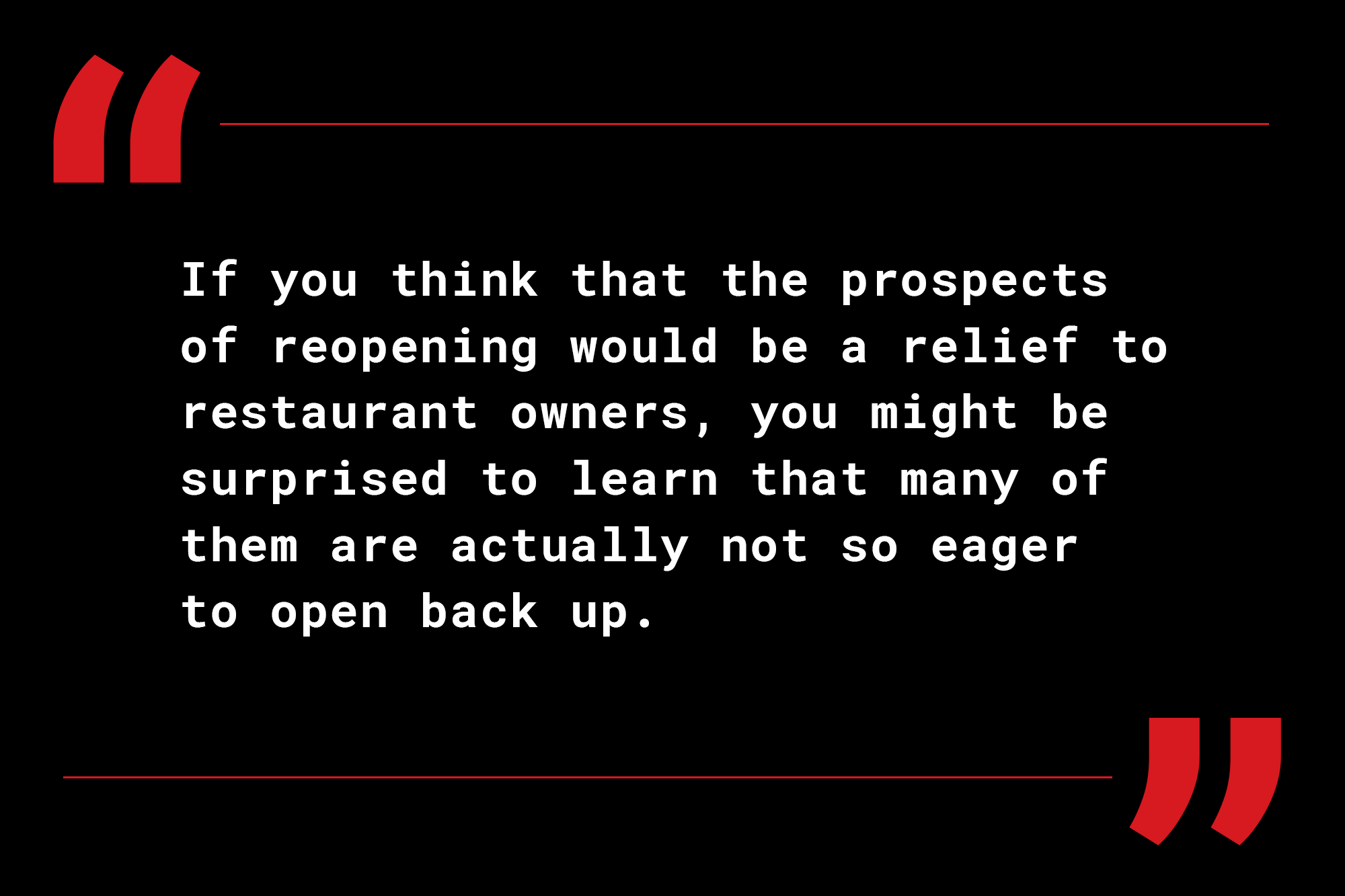Restaurants Ponder Reopening During COVID-19
The rules are changing, which means that soon restaurants will be able to open their doors to diners. If you think that the prospects of reopening would be a relief to restaurant owners, you might be surprised to learn that many of them are actually not so eager to open back up. The reasons why this might be the case are numerous and not that complicated. In this post I’m going to outline just a few key factors, based on tons of reading and several conversations with restaurateurs, colleagues and friends in the restaurant business, why some owners are thinking twice about opening their dining rooms.
The Wait And See Approach
Some restaurant owners want to wait and learn from others’ mistakes. They don’t want to be the first out of the gate, because with experimentation comes greater risk. And that’s what this reopening is, an experiment. There’s no telling what will happen, and it might benefit a restaurant to see how others deal with reopening. As one of my graduate school professors used to love repeating, “The second mouse gets the cheese.” I personally do not live by this creed, but I think it’s fair, in this climate, that some people would take a wait and see approach, especially with so much on the line. It might pay, literally, to see what’s working and what’s not as others take the leap. In a way, all of us in Boston have an advantage, because we are able to see how other cities that are already reopening are dealing with this scenario.
Staff Welfare
Another reason some restaurant owners might be hesitant to open has to do with staffing. Good business owners know that they have a tremendous responsibility for the welfare of their team. By reopening, some owners feel they are putting the staff at financial risk. If things don’t work out because of the lack of general business, or prospects of another shut down (yeah, it could happen), it would force employers to do layoffs once again, forcing their team to seek unemployment one more time. And that process is not easy, as we discovered in mid-March. Plus, those currently collecting unemployment are making an extra $600 a week now with benefits. It’s hard to ask your staff to leave that income behind to help rebuild without a certain level of confidence that things will work out.
And what about the fear of putting their people in harm’s way? Are we truly clear of that risk? Many restaurant owners shut down before they were asked to because they didn’t feel comfortable possibly exposing their employees to this potentially deadly virus. Although numbers aren’t on a steep incline like they were in March, there are some people out there that feel it’s too early to start populating our cities. Their concern for possible exposure to their staff and customers hasn’t changed. Just because they can open up, it doesn’t mean they feel it’s safe to do so. Expect some hold outs for this reason alone.
Financial Implications of Limited Capacities
Finally, there’s been a lot of discussion about whether it’s financially feasible for a restaurant to open with limited capacities. It’s logical. How will a restaurant, whose business model is tied so closely to the number of seats, be able to make ends meet with only half (or less) of those necessary seats available? And timing couldn’t be worse. Many restaurants rely on these spring and summer months to carry them for the rest of the year, so what happens when there isn’t enough cash generated to get them through those slower months? It’s very possible that we see some restaurants open again in the near future, only to close because they won’t have enough money to survive the winter.
In a recent panel I attended online, one of the restaurateurs said bluntly that it didn’t make sense to open with 50% or less capacity, because at that volume it will cost more money to be open than closed. For a new restaurant, that loss might be acceptable or even expected in their first months open, but for a seasoned restaurant, looking towards a very uncertain future, there’s no real upside to taking on such losses. And if you’re thinking that takeout business fills this gap, think again. It’s not even close.
Let’s not forget that opening after shutting down will take a large initial investment. On top of the usual expenses that it takes to keep a restaurant open like rent, utilities, vendors, and pest control (sorry, but that’s not an unusual recurring expense for most restaurants), restaurants will be required to restock and hire cleaning crews, among other things. This will especially be the case for restaurants that closed completely, or gave away inventory to prevent waste and generate goodwill. If a restaurant were to reopen, those costs have to be recouped quickly, and that most certainly will not happen at low capacities.
—
All of this is scary stuff, no doubt, but it’s not game over by any stretch of the imagination. People in this particular line of work are fighters. They are scrappy. They have a passion for this business that is more in line with making art than money. Things were already difficult for them before this crisis, and you probably never knew it. They will open when it makes sense for them to open. All we can do is be there for them when that time is right and to let them know that the struggle was worth it.




